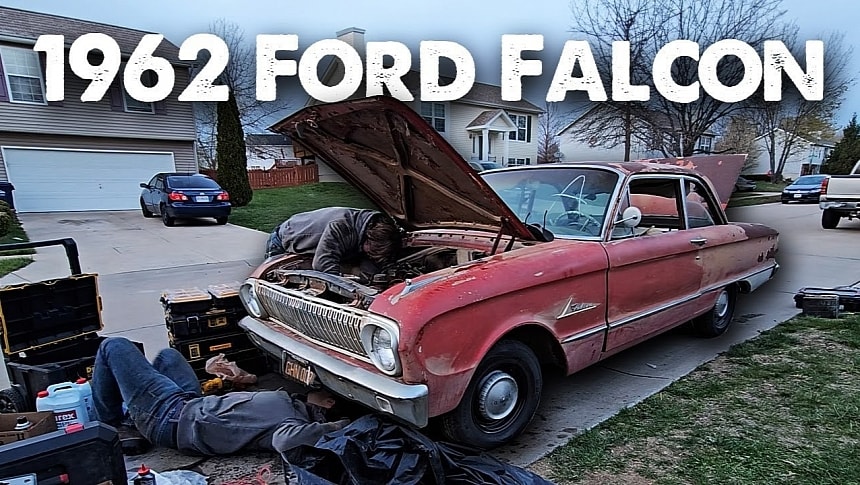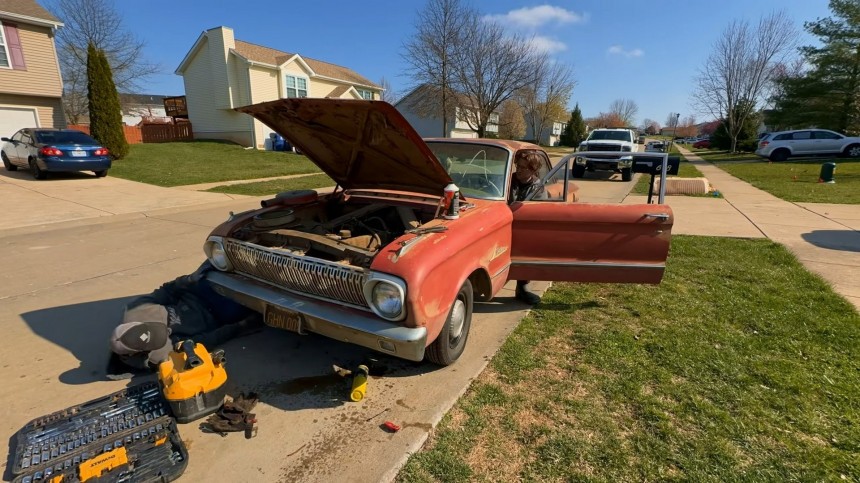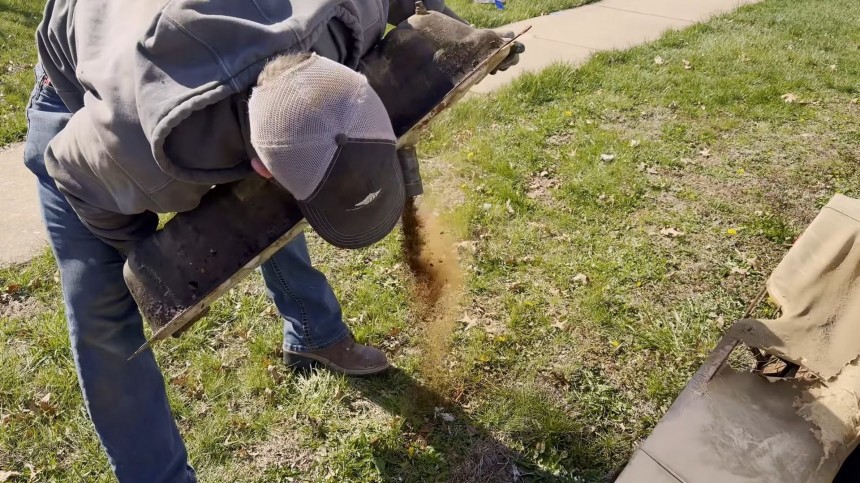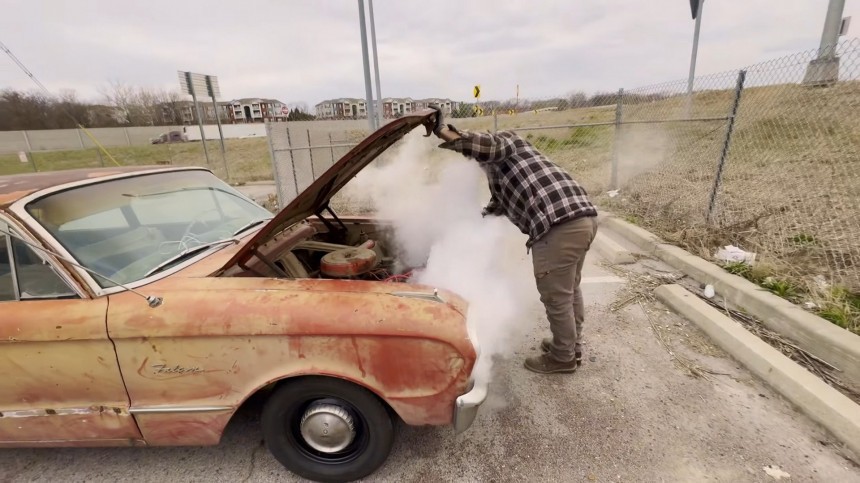In 1960, Ford released the Falcon to spread its compact wings over the exuberant, youthful decade ahead. The car did very well in the first three years, opening a niche and setting sales records before the 1964 asteroid impact blew Planet Piston into the pony car tyranny. The Mustang was a completely new car based largely on the Falcon’s underpinnings, overshadowing its spiritual forerunner forever.
The Ford Falcon was a nice little car that served its purpose well but didn’t rise to the status of Americana legend in the following decades. Occasionally, It is still a fun find, if and where one is found, but even car people don’t rush after them like bees to honey. And yet, getting the chance to wrench on one is always an opportunity too good to pass for car nuts.
The DailyDrivenDeathTraps YouTube channel stumbled upon a 1962 Falcon Deluxe Tudor Sedan (two-door coupe, translated from marketing Fordese into plain English) in California since 1982. The last time it ran was 1988, which can be good or bad, depending on the situation.
Because it’s from California, the surface rust self-identifies as ‘patina,’ the car is still in one piece, with no additional corrosion-based ventilation and weight reduction. Under the hood sits the base 144-cubic-inch (2.4 liters) Falcon Six mated to the optional two-speed automatic (Fordomatic was the advertising nomenclature of the transmission). Spoiler alert: the classic salvagers look for third gear at one point in their attempt to revive the old car and put it back on the road. More on that in a minute.
The good part of this fix-and-drive-home project is that the car is complete, albeit non-running, and the engine bay real estate offers ample room for dumping enough elbow grease to get the engine back to life. The not-so-good part is that this car has issues and an attitude to match.
After changing the distributor, swapping the Ford generator with a Chevrolet alternator (genius or sacrilege?), getting the brakes gone through, and bypassing the fuel tank (that is probably the only part of the car with holes in it), the car finally runs and drives.
Alex and Sean originally planned to drive 350 miles (some 560 km). Still, after two days of curbside wrenching, the car appears to cooperate just fine. By that, I mean the engine runs, and the vehicle moves on its power – eventually – as demonstrated by a short test drive at night. The following morning falls right into every real-life old car rescue scenario when at least one issue emerges out of the blue.
In this case, after a five-mile drive, the car just gives up on dear life and falls flat on its face on the side of the road. What more could one ask for? Apparently, the problem is a leaking cooling system—doubled by a carburetor in cardiac arrest. The one-barrel fuel mixer is far from its prime, but the big uh-oh is the water pump.
Any gearheads are aware of a contagious habit that circulated in the warm parts of America, namely car owners using tap water for coolant (no antifreeze, because why should you buy it if you live in a place where winters are just calendar months?). With cars sitting for decades – like this Falcon – rust will eventually clog the cooling passages.
The six pistons reciprocate, but the mechanically-inclined viewers suspect a blow-by from one of them when the YouTubers fill the radiator with fresh coolant (play the video at 42:38), and it starts to bubble at idle. Soon after that, one of the hoses decides it’s high time to become the main character of this rescue and generously frees the coolant on the road.
The answer to the question in the video's title is a resounding ‘Not today, pal.’ The 1962 Ford Falcon Deluxe Tudor won’t drive 350 miles, having barely crawled five of them before having a seizure. It’s a reality many piston addicts have experienced at least once, so cut the YouTubers some slack for this successful fail on the first try.
They’ll be back for the car, and the Falcon will fly again – it’s too original to drag it to a scrap yard, too cool to pass, and too annoyingly classic to give up on it. At one point in the video (around 28:50), the mechanics drive the car to try to get the automatic gearbox to shift into third.
They failed – had they succeeded, it would have been the internet sensation since the 1962 Falcons had a three-speed manual transmission as standard and a two-speed auto as an alternative. Just an honest mistake and the least of their concerns for this project since the tranny is shifting well.
The two-door Falcon (Standard and Deluxe combined) was the most popular of the 13 model versions offered by Ford Motor Company in 1962, with 143,650 units assembled out of nearly 400,000 Falcons of all body styles and trims. That's not too bad, considering that year's 1.38 million-car Ford production. They were cheap to buy and friendly on the wallet—especially the 144-cube Six with a three-speed manual. One such Falcon scored a 32.6 miles-per-gallon (7.2 liters/100 km) fuel economy record in an independent comparative test.
It wasn’t a powerhouse, with 84 hp and 134 lb-ft (85 PS, 182 Nm), but it got the job done—at a snail’s pace. A Car Life test performed in March 1962 revealed an acceleration time of 6.7 seconds—from zero to 30 mph (48 kph)! It took nearly three times as much for the little engine to move the car (with a two-speed auto) to the benchmark 60 mph speed (97 kph)—24.7 seconds.
The DailyDrivenDeathTraps YouTube channel stumbled upon a 1962 Falcon Deluxe Tudor Sedan (two-door coupe, translated from marketing Fordese into plain English) in California since 1982. The last time it ran was 1988, which can be good or bad, depending on the situation.
Because it’s from California, the surface rust self-identifies as ‘patina,’ the car is still in one piece, with no additional corrosion-based ventilation and weight reduction. Under the hood sits the base 144-cubic-inch (2.4 liters) Falcon Six mated to the optional two-speed automatic (Fordomatic was the advertising nomenclature of the transmission). Spoiler alert: the classic salvagers look for third gear at one point in their attempt to revive the old car and put it back on the road. More on that in a minute.
After changing the distributor, swapping the Ford generator with a Chevrolet alternator (genius or sacrilege?), getting the brakes gone through, and bypassing the fuel tank (that is probably the only part of the car with holes in it), the car finally runs and drives.
Alex and Sean originally planned to drive 350 miles (some 560 km). Still, after two days of curbside wrenching, the car appears to cooperate just fine. By that, I mean the engine runs, and the vehicle moves on its power – eventually – as demonstrated by a short test drive at night. The following morning falls right into every real-life old car rescue scenario when at least one issue emerges out of the blue.
Any gearheads are aware of a contagious habit that circulated in the warm parts of America, namely car owners using tap water for coolant (no antifreeze, because why should you buy it if you live in a place where winters are just calendar months?). With cars sitting for decades – like this Falcon – rust will eventually clog the cooling passages.
The six pistons reciprocate, but the mechanically-inclined viewers suspect a blow-by from one of them when the YouTubers fill the radiator with fresh coolant (play the video at 42:38), and it starts to bubble at idle. Soon after that, one of the hoses decides it’s high time to become the main character of this rescue and generously frees the coolant on the road.
They’ll be back for the car, and the Falcon will fly again – it’s too original to drag it to a scrap yard, too cool to pass, and too annoyingly classic to give up on it. At one point in the video (around 28:50), the mechanics drive the car to try to get the automatic gearbox to shift into third.
They failed – had they succeeded, it would have been the internet sensation since the 1962 Falcons had a three-speed manual transmission as standard and a two-speed auto as an alternative. Just an honest mistake and the least of their concerns for this project since the tranny is shifting well.
It wasn’t a powerhouse, with 84 hp and 134 lb-ft (85 PS, 182 Nm), but it got the job done—at a snail’s pace. A Car Life test performed in March 1962 revealed an acceleration time of 6.7 seconds—from zero to 30 mph (48 kph)! It took nearly three times as much for the little engine to move the car (with a two-speed auto) to the benchmark 60 mph speed (97 kph)—24.7 seconds.











































